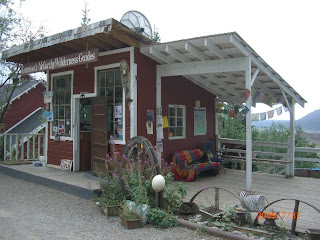After crossing back into the Yukon on the Haines Highway, the route followed Highway 3 north to Haines Junction. Once again, we fueled up in Haines Junction and then continued north on Highway 1 towards Kluane lake.

At the south end of the lake, a new bridge was being constructed over the Slims river.


We stopped in at the Parks Visitor centre (
Kluane National Park Reserve)- which sported solar panels and windmills for power, but the doors were locked.

It looked like great sheep terrain in the surrounding mountains.

The silty waters of the river mouth contrasted sharply with the green waters of Kluane Lake.

Sections of the road had been recently re-built, but were in good shape. Further north, past
Destruction Bay and Burwash Landing, the permafrost got the better of the roads, and the roller coaster began again!

We stopped at a small lakeside pull off near Beaver Creek, and considered spending the night, but it was still early, and it was a bit close to the main road.

There were some 'attack ducks' that came to investigate us, as well as some swans swimming in the lake. So we carried on towards the US boundary.

We did go past the Canadian customs station at the Beaver Creek airport, then found a side road and a comfortable gravel pit to play some frisbee and spend the night!
lat 62.409126 lon -140.852490

In the morning, we got to the US border, but there was no customs station in sight, just some joint Canada/US plaques and displays when crossing the line.

If you click on these photos, you can 'almost' read the text on them.

There was even a bench the straddled the line; half in each country. I wonder who paints it?

I think it was more a factor of being too far west rather than too far north, but my Sirius satellite radio pretty much stopped working around here. But it still worked better than the built-in XM radio in my GM truck - which seems to be stymied by any trees or mountains or anything to the south. Of course, on this particular trip the truck camper overhang covers the XM antenna on the cab roof, so it did not provide good service anywhere.

It was about 30 miles before reaching US customs, and the smoke from area forest fires began to limit the views. The roller coaster ride continued from the roads built over melting permafrost.
Next on the radar - Tetlin and Tok, Alaska
 The very rich copper deposit was discovered in 1900, which required the construction of 196 miles of railroad to service the mine, leading to the coast at Cordova.
The very rich copper deposit was discovered in 1900, which required the construction of 196 miles of railroad to service the mine, leading to the coast at Cordova. The mine has been abandoned since 1938, but was taken over by the National Park Service in 1998, and they are attempting to restore or stabilize some of the buildings on site.
The mine has been abandoned since 1938, but was taken over by the National Park Service in 1998, and they are attempting to restore or stabilize some of the buildings on site. There was a large flood in recent history that damaged many of the structures and a bridge.
There was a large flood in recent history that damaged many of the structures and a bridge. Some of the bunkhouse accommodations for workers at the mine.
Some of the bunkhouse accommodations for workers at the mine. A (stabilized) rail car loading area.
A (stabilized) rail car loading area. One of the huge ore processing buildings built on a steep hillside.
One of the huge ore processing buildings built on a steep hillside.
 Some pretty incredible buildings and heavy equipment, especially for that era.
Some pretty incredible buildings and heavy equipment, especially for that era.
 A view of the edge of the mine property, looking up towards the Kennicott glacier. They meant to name the mine after the glacier, but mis-spelled it as Kennecott!
A view of the edge of the mine property, looking up towards the Kennicott glacier. They meant to name the mine after the glacier, but mis-spelled it as Kennecott! Even though it was the end of July, because of the proximity of the glaciers, it was fairly cool around the mine site.
Even though it was the end of July, because of the proximity of the glaciers, it was fairly cool around the mine site. But, not too cool for this bumble bee!
But, not too cool for this bumble bee! Some of the historic vehicles and shacks on the way back down to the quaint (putting it mildly) village of McCarthy - next.
Some of the historic vehicles and shacks on the way back down to the quaint (putting it mildly) village of McCarthy - next.









































